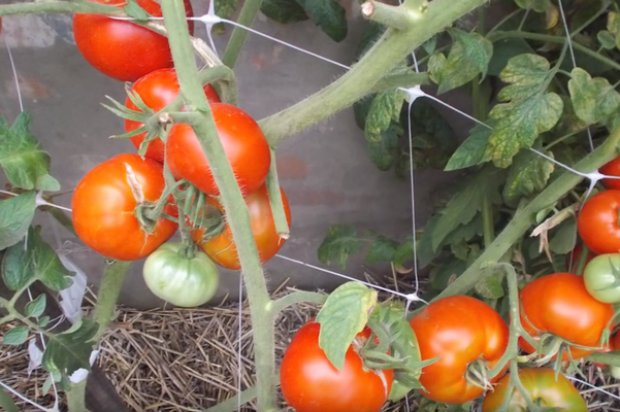 Neighborhoods of St. Petersburg are not spoiled either by the abundance of sunny days or by the fertility of the soil. Plus, frequent rainfall, high humidity ... The conditions for growing tomatoes are not very suitable.
Neighborhoods of St. Petersburg are not spoiled either by the abundance of sunny days or by the fertility of the soil. Plus, frequent rainfall, high humidity ... The conditions for growing tomatoes are not very suitable.
But after all, amateur gardeners who live in such an unflattering climate, want to grow good crops! It is for this purpose that the breeder, the author of many books on the effective cultivation of vegetables, Bekseev Sh.G. brought a variety of tomato Palace. In the Leningrad region, it is recommended for cultivation in greenhouses. In more southern latitudes it will successfully grow and bear fruit also in open ground conditions.
Content
Main characteristics
- Medium-sized - 130-160 cm.
- Early ripening.
- Low-seeded.
- Super-yielding: from one bush, with proper agricultural technology, you can collect more than 4.5 kg of fruits, from 1 sq. Km. m - 12-14 kg.
- Fruits of medium size: mainly 250-300 g, grow to a maximum of 600-700 g, rounded flattened. Bright red with a smooth thin skin. Not prone to cracking. Great for pickling, and for fresh consumption, for example, in salads.
- Determinant grade.
- You will need to pinch and tie up the bushes.
- The first flower brush grows over the 6-7th leaf, the next - after each 3-4th leaf.
- Spreading bush with powerful trunks.
- With proper care, it is quite resistant to the main diseases of tomatoes and to sudden changes in temperature.
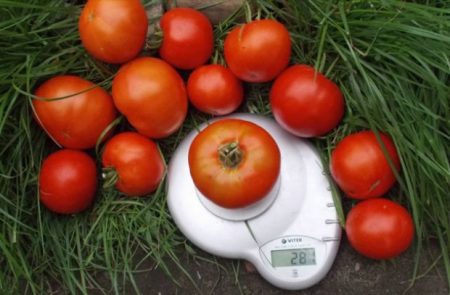
On a note
- An important feature: plants of this variety are very "gluttonous": to get a good crop, they should be fertilized every 2-3 days. In the heat, liquid fertilizing should be watered even more often - once every 1-2 days. At least, such advice is given by the author of the variety Sh. G. Beckseev. And since frequent top dressing involves plentiful moisture, growing Palace tomato in a greenhouse, its doors should often be left open for ventilation. Otherwise, in conditions of high humidity, diseases can begin to develop.
- During flowering and fruit setting, it is advisable to shake the bushes for better pollination.
Seedlings for seedlings
- Sown 60-65 days before transplanting into the greenhouse or in the beds.
- It is advisable to prepare the seeds for sowing - soak for 2-3 hours in biostimulants - "Epine", "Zircon", "EcoSile". You can use aloe juice. For this, the aloe tree leaf is cut from the plant a week before the procedure. And all this time they keep in the refrigerator to maximize the activation of biologically active substances. Then juice is squeezed out of the sheet, 1 teaspoon of it is diluted in 0.5 l of water. A little liquid is cast from the can and the seed is soaked in it.
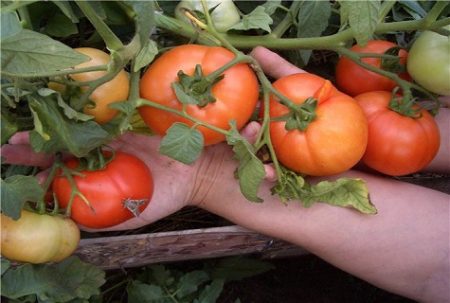
- Along with the usual storey seeds, perlite, vermiculite, and agro-perlite can also become excellent soil for seed germination. They perfectly retain moisture, on nutrition - scarce, without the addition of fertilizers (they are completely unnecessary for seeds to successfully germinate and can even harm).The consistency resembles loose fine sand, therefore, it is very convenient to extract sprouts with roots from such soils: even the smallest processes of roots do not get injured.
- The know-how of gardeners in the last few seasons is the germination of seeds in ... drunk tea bags. Those who used this technique say that the seeds germinate faster and supposedly get an excellent “charge” for further growth in tea leaves, which makes them grow faster, stronger and healthier, unlike seedlings grown under other conditions. You can try to experiment!
- Shoots appear at a temperature of about + 20 degrees. Therefore, it is advisable to keep the sowing plates until emergence, for example, on the battery.
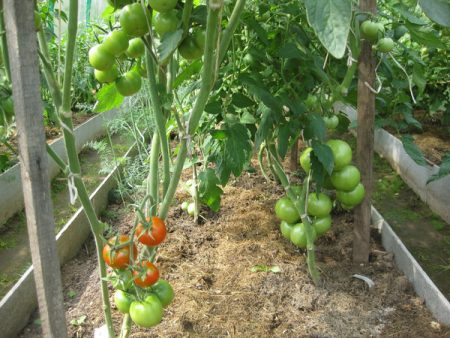
- With the advent of the first true leaflets, seedlings should be peaked in separate containers so that there is enough nutrition for the forming bush.
- It is important to place containers with seedlings on the lightest windowsill, ideally - south, southeast or southwest orientation. If the sun shines very brightly at noon, seedlings should be shaded. A great option for this is the curtains on the windows. If they are not, you can obscure the young plants with a sheet of paper leaning against the window glass.
- Seedlings should be grown - on the contrary, in nutrient soil. You can use ordinary storefront ("Seedling") or mix compost, garden soil and coarse sand (2: 2: 1).
- The seedling scourge is the so-called “black leg”. It spreads lightning fast. It happens that for no reason at all, almost all seedlings lie in a bowl during the day. It starts with the fact that in the first cases the stem near the ground becomes thinner and darker: as if a young plant cows and falls to the ground. For the prevention of this fungal disease, “Phytosporin” is used, it is introduced into the soil during its pre-sowing preparation.
- Seedling care is simple: timely irrigation, loosening of the soil (so that air arrives to the roots faster), combined with irrigation of fertilizing with complex mineral fertilizers 1 time per week. The dose of fertilizer recommended in the instructions is best reduced by 2 times.
- It is important to avoid drafts! Because of them, tomato seedlings can not only get sick, begin to lag behind in development, but also die.
- Growing plants stretch towards the sun's warmth and light, due to which still unstable stems can bend. Therefore, containers with seedlings should be periodically turned over with the opposite side with respect to the window glass.
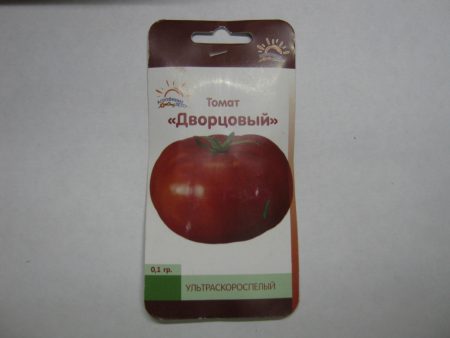
- Before planting in open ground, it is advisable to harden the seedlings - gradually begin to accustom them to open air and lower night temperatures. You can take out on the veranda at first for several hours, gradually increasing this time. Then leave there for the night, later - put up to sleep in the yard. Hardening usually takes a couple of weeks. This procedure will help tomato bushes quickly adapt to new conditions, save them from slowing down in development, and help plants survive the transplant stress faster and with less loss.
Sowing in the greenhouse and in the open ground
- Tomato seedlings are transplanted to the garden when positive night temperatures are established on the street. It is important to be sure that return frosts are finally gone.
- For 1 square. m will feel comfortable and not lack nutrients 3-4 bushes.
- The distance between rows and plants is 35-40 cm.
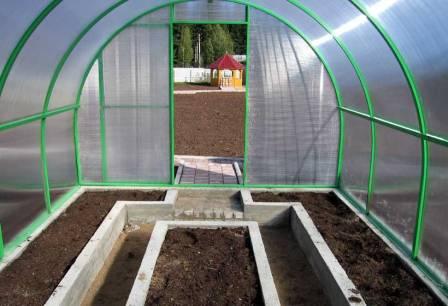
- The depth of the landing hole is about 5 cm. Given the fact that the soil on the bed was prepared in advance and improved by the application of horse manure, for example (in the fall). If not, then the depth of the pit should be made about 15-20 cm and the nutrient layer of compost should be laid on the bottom with the addition of complex mineral fertilizers (the dose of application is as indicated in the instructions attached to the preparation). Indeed, Palace tomato is a “gluttonous” variety! It is important not to get carried away too much with nitrogen, otherwise the foliage will grow abundantly and densely, to the detriment of the quality and size of the fruit.
- About a week after planting, the tomato bushes should be tied up and then do this regularly as they grow.
- It is ideal to leave one stem, and on it allow 5-6 flower brushes to form. If the soil is very nutritious - then 6-7 brushes. To stop the formation of flower brushes is very simple: just pinch the top of the bush at the right time.
- Be sure to remove unnecessary leaves: to the first brush - absolutely everything, above it - through one. When all the fruits are set and approximately reach their size, all leaves must be removed from the plant.
- Do not forget to often feed and ventilate the greenhouse well! The first top dressing is 7-10 days after planting, by this time the roots should already have time to adapt in the new soil.
Feedback
Great variety! I was glad that I completely frustrated before the onset of late blight. In each brush - 4-6 fruits, large enough. And in general, the productivity pleased. Growing in three stems, they should not be left more. I would put the grade a strong four, perhaps even with a plus.
Peter Arkadevich
For the first time, I cultivated Palace Tomatoes 2 years ago. Then they were not very successful. The year was too wet, and late blight developed in the greenhouse. The following year, I laid a good weight on feeding, the weather was sunny, but I was constantly seated to ventilate the greenhouse. It was possible to grow a good crop, the weight of one “tomato” reached 500 g. In our country, in the Leningrad Region, not every tomato variety will grow, I would call “Palace” one of the best among those that I had to try to plant in a greenhouse.
Daria Valentinovna
I liked that this variety bears fruit for a very long time: from late June to mid-September. The fruits are palatable, fleshy, with a couple you can cut a plate of salad. And stored on the balcony is not bad.
Vasily Nikolaevich




 Low-growing tomatoes, without pinching: 5 of the most delicious varieties
Low-growing tomatoes, without pinching: 5 of the most delicious varieties Why tomato seedlings grow poorly
Why tomato seedlings grow poorly We grow a tomato in a shell
We grow a tomato in a shell Growing tomatoes without watering according to the method of Kazarin
Growing tomatoes without watering according to the method of Kazarin